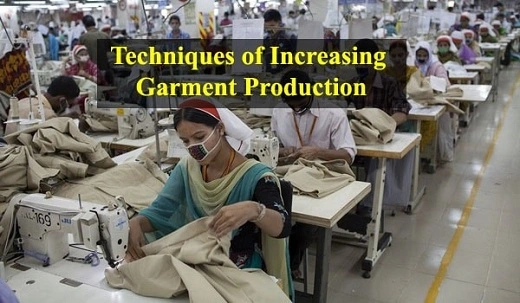Factors and Techniques of Increasing Productivity in the Garments Industry
Both production and productivity should be always high in this competitive era or apparel manufacturing. Productivity is a quantitative relation between what we produce and what we use as resources to produce them, i.e arithmetic ratio of the amount produced (output) to the amount of resources (input). In this article, we present Factors and Techniques of Increasing Productivity in the Garments Industry.
Production is concerned with the activity of producing goods or services. Productivity is concerned with the effective utilization of resources (inputs) to produce goods or services. Every apparel manufacturing industry wants higher productivity. Because higher productivity brings higher profit margins in the apparel business. The garment industry is labor-oriented. So production depends on labor efficiency. There are some factors to improve productivity in the apparel industry. So to increase productivity in the garments industry have to follow techniques. In this article, I will discuss key factors and techniques to improve production in the garment industry.
How Productivity Can Be Increased in The Garments Industry
R&D and IE departments in the apparel industry always try how to increase production. From my experience, I think the following ways can increase productivity in the garment industry:
- Increasing the production (output) without increasing the inputs.
- Keeping the production the same but decreasing the inputs.
- Reducing the wastage and rejection rate.
- Increasing the rate of output compared to the rate of input.
- Establishing reasonable goals for improvements.
- Applying automation and using modern technology.

Factors Influencing Productivity in the Garments Industry
Productivity is influenced by the following two categories of factors:
A. Controllable or internal factors:
- Type of product
- Plant and equipment
- Material and energy
- Human
- Technology and automation
- Work method
- Management policy
- Financial factors
B. Non-controllable or external factors:
- Structural adjustment
- Availability of resources
- Socio-economic factors
- Political factors (Govt. policy)
- Infrastructure
Benefits of higher productivity in garment production
Some of the benefits that accrue from higher productivity are given below:
- Higher productivity means higher profit. This can be understood easily by the following relation:
- Profit = Revenue – Cost of goods or services
- Higher productivity in the garment industry is translated into higher real earnings for its employees.
- The public realizes more social benefits because of increased public revenues.
- The customer has to pay relatively low prices because the cost of manufacturing is reduced through higher productivity.
Productivity Improvement Techniques in the Garments Industry
Productivity is a frequently talked topic in any garment factory. I think the following techniques will improve productivity in the readymade garment industry:
A. Technology based techniques:
- Computer-aided design (CAD)
- Computer-aided manufacturing (CAM)
- Integrated CAM
- Robotics
- Laser beam technology
- Energy technology and conservation
- Computer graphics
- Simulation software
- Modern maintenance management
- Hybrid or group technology
B. Product based techniques:
- Value engineering
- Product diversification
- Product simplification
- Research and development
- Product standardization
- Product reliability improvement
- Advertising and promotion
C. Material based techniques:
- Inventory management and control
- Material requirement planning (MRP)
- Material control
- Quality control
- Improved material handling
- Reuse and recycling
D. Employee based techniques:
- Financial incentives
- Fringe benefits
- Promotions
- Job enrichment
- Job enlargement
- Job rotation
- Worker participation
- Skill enhancement
- Communication improvement
- Learning curve
- Training
- Education
- Role perception
- Supervision quality
- Recognition
- Punishment
- Management by objectives (MBO)
E. Task-based techniques:
- Work study (Time and method study)
- Method engineering
- Job design
- Job evaluation
- Job safety design
- Ergonomics
- Production scheduling
- Computer aided data processing
Discover more from Textile Industry
Subscribe to get the latest posts sent to your email.
